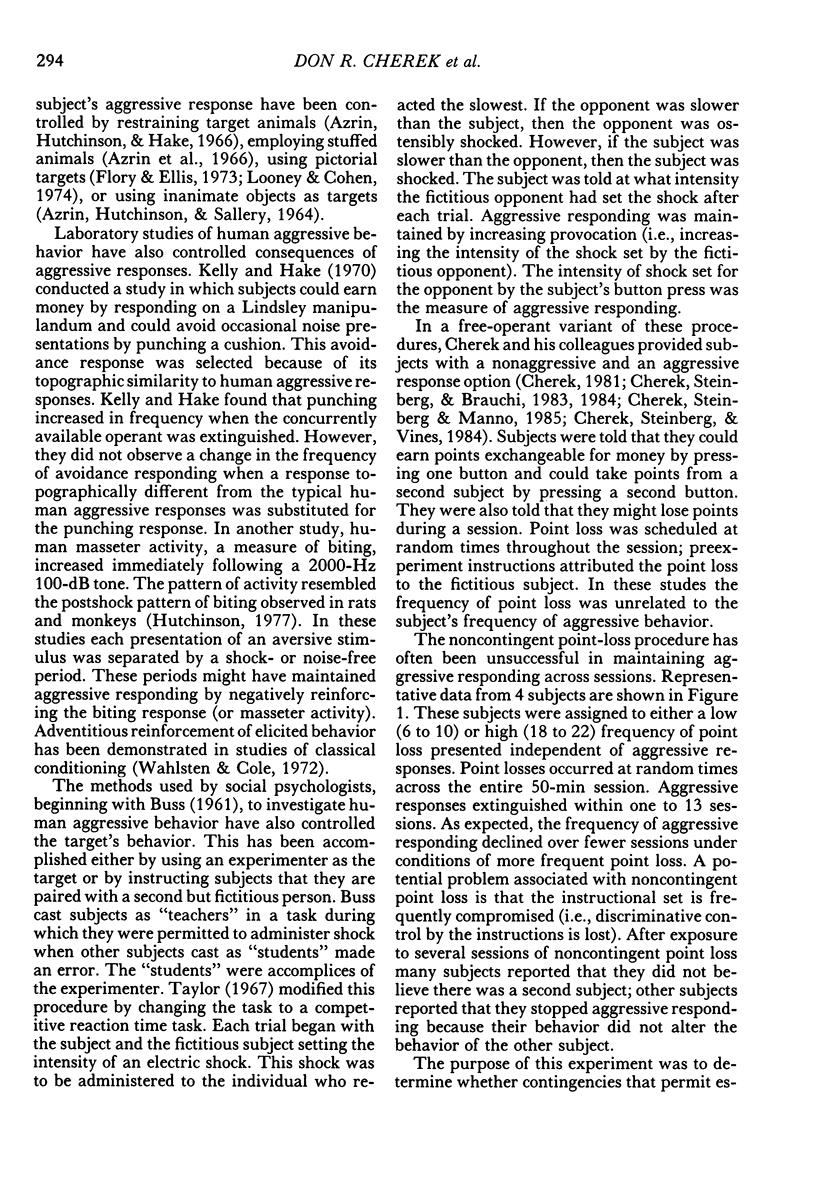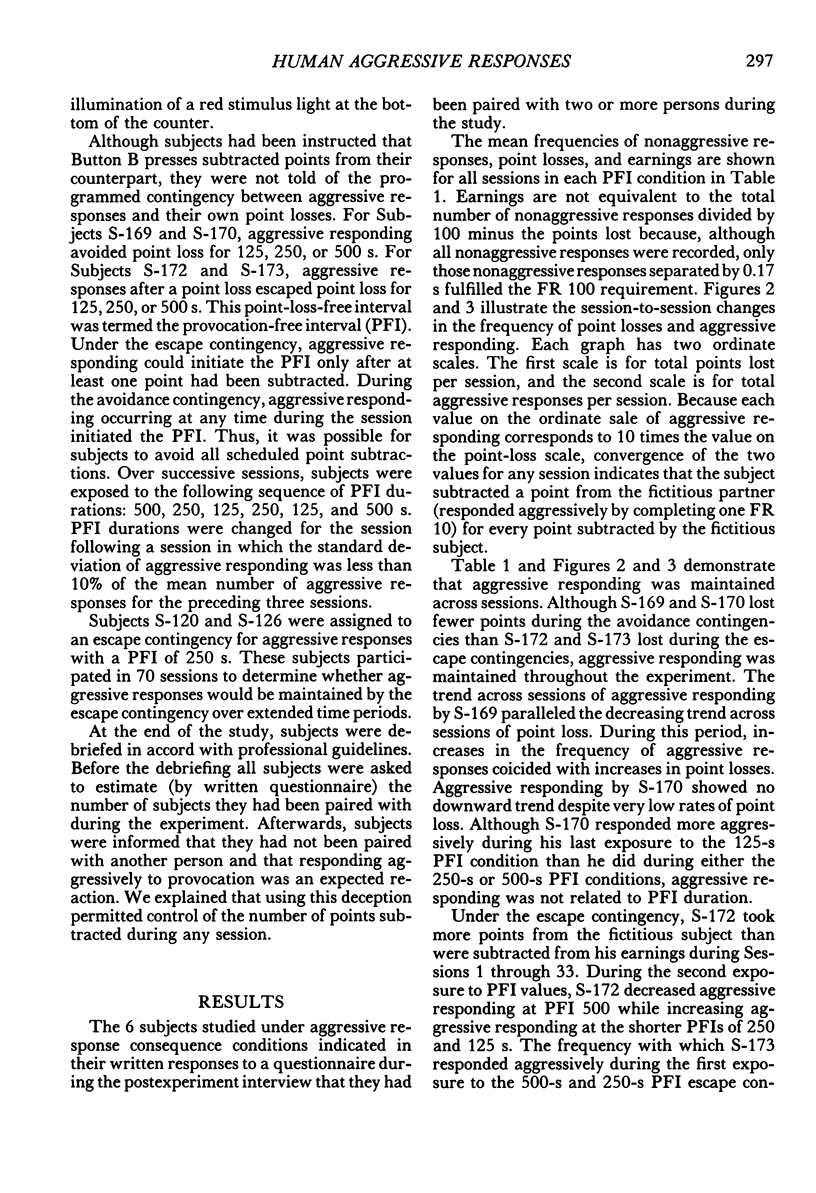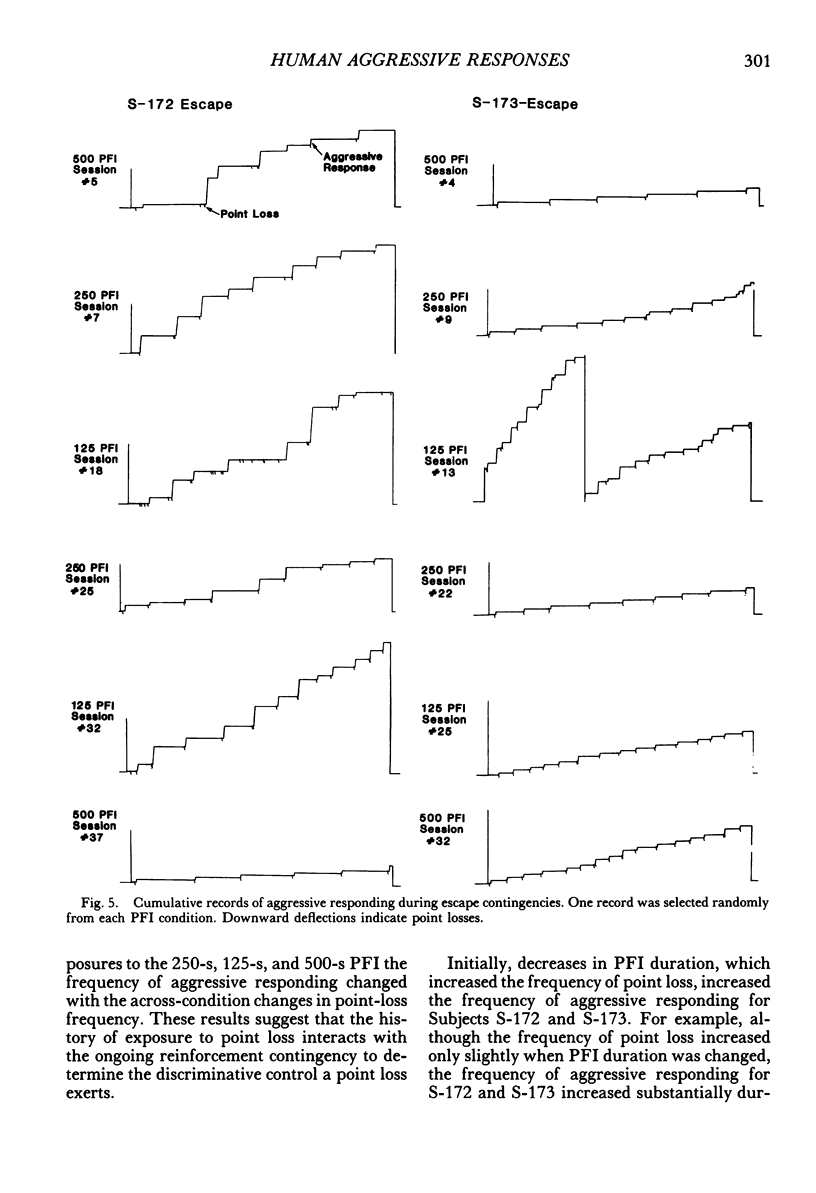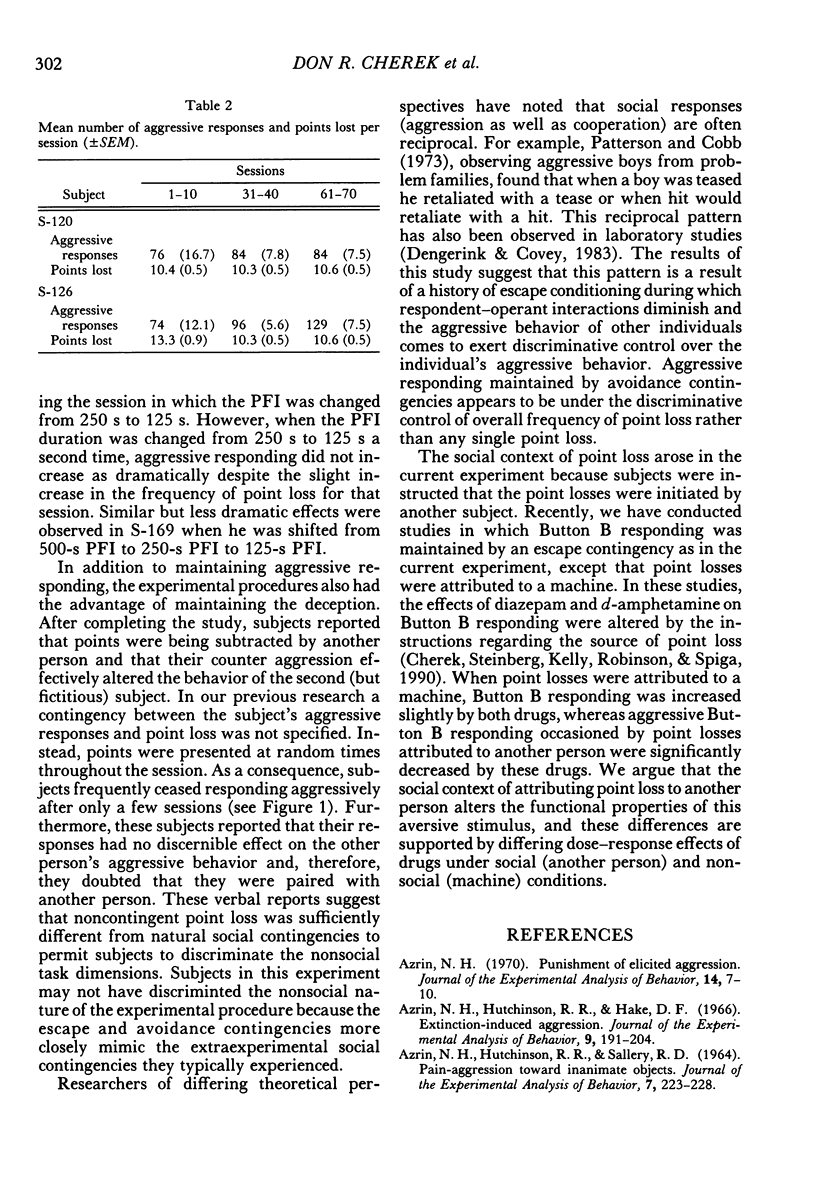Abstract
During 50-min sessions, 6 male human subjects could press either Button A or Button B available as nonreversible options. Button A presses were nonaggressive responses and earned points according to a fixed-ratio 100 schedule. Prior to the experiment subjects were instructed that every 10 (fixed-ratio 10) Button B presses (aggressive responses) subtracted a point from a fictitious 2nd subject. A random-time schedule of point loss was used to engender aggressive responding. The instructions attributed these point losses to the Button B presses of the subject's fictitious partner. Aggressive responding either escaped or avoided point loss by initiating an interval free of point loss. The duration of the interval was varied systematically across sessions. Avoidance contingencies maintained a high rate of aggressive responding over 30 sessions in the absence of point loss. Escape contingencies also maintained aggressive responding across sessions, with rates of aggressive responding corresponding to rates of point loss.
Full text
PDF










Selected References
These references are in PubMed. This may not be the complete list of references from this article.
- AZRIN N. H., HUTCHINSON R. R., SALLERY R. D. PAIN-AGGRESSION TOWARD INANIMATE OBJECTS. J Exp Anal Behav. 1964 May;7:223–228. doi: 10.1901/jeab.1964.7-223. [DOI] [PMC free article] [PubMed] [Google Scholar]
- Azrin N. H., Hutchinson R. R., Hake D. F. Extinction-induced aggression. J Exp Anal Behav. 1966 May;9(3):191–204. doi: 10.1901/jeab.1966.9-191. [DOI] [PMC free article] [PubMed] [Google Scholar]
- Azrin N. H. Punishment of elicited aggression. J Exp Anal Behav. 1970 Jul;14(1):7–10. doi: 10.1901/jeab.1970.14-7. [DOI] [PMC free article] [PubMed] [Google Scholar]
- Cherek D. R. Effects of smoking different doses of nicotine on human aggressive behavior. Psychopharmacology (Berl) 1981;75(4):339–345. doi: 10.1007/BF00435849. [DOI] [PubMed] [Google Scholar]
- Cherek D. R., Steinberg J. L., Brauchi J. T. Effects of caffeine on human aggressive behavior. Psychiatry Res. 1983 Feb;8(2):137–145. doi: 10.1016/0165-1781(83)90101-4. [DOI] [PubMed] [Google Scholar]
- Cherek D. R., Steinberg J. L., Brauchi J. T. Regular or decaffeinated coffee and subsequent human aggressive behavior. Psychiatry Res. 1984 Mar;11(3):251–258. doi: 10.1016/0165-1781(84)90073-8. [DOI] [PubMed] [Google Scholar]
- Cherek D. R., Steinberg J. L., Kelly T. H., Robinson D. E., Spiga R. Effects of acute administration of diazepam and d-amphetamine on aggressive and escape responding of normal male subjects. Psychopharmacology (Berl) 1990;100(2):173–181. doi: 10.1007/BF02244402. [DOI] [PubMed] [Google Scholar]
- Cherek D. R., Steinberg J. L., Manno B. R. Effects of alcohol on human aggressive behavior. J Stud Alcohol. 1985 Jul;46(4):321–328. doi: 10.15288/jsa.1985.46.321. [DOI] [PubMed] [Google Scholar]
- Cherek D. R., Steinberg J. L., Vines R. V. Low doses of alcohol affect human aggressive responses. Biol Psychiatry. 1984 Feb;19(2):263–267. [PubMed] [Google Scholar]
- Kelly J. F., Hake D. F. An extinction-induced increase in an aggressive response with humans. J Exp Anal Behav. 1970 Sep;14(2):153–164. doi: 10.1901/jeab.1970.14-153. [DOI] [PMC free article] [PubMed] [Google Scholar]
- Kelly T. H., Cherek D. R., Steinberg J. L., Robinson D. Effects of provocation and alcohol on human aggressive behavior. Drug Alcohol Depend. 1988 May;21(2):105–112. doi: 10.1016/0376-8716(88)90055-5. [DOI] [PubMed] [Google Scholar]
- Looney T. A., Cohen P. S. Pictorial target control of schedule-induced attack in White Carneaux pigeons. J Exp Anal Behav. 1974 May;21(3):571–584. doi: 10.1901/jeab.1974.21-571. [DOI] [PMC free article] [PubMed] [Google Scholar]
- Patterson G. R., Littman R. A., Bricker W. Assertive behavior in children: a step toward a theory of aggression. Monogr Soc Res Child Dev. 1967;32(5):1–43. [PubMed] [Google Scholar]
- REYNOLDS G. S., CATANIA A. C., SKINNER B. F. Conditioned and unconditioned aggression in pigeons. J Exp Anal Behav. 1963 Jan;6:73–74. doi: 10.1901/jeab.1963.6-73. [DOI] [PMC free article] [PubMed] [Google Scholar]
- Schmitt D. R. Interpersonal contingencies: Performance differences and cost-effectiveness. J Exp Anal Behav. 1987 Sep;48(2):221–234. doi: 10.1901/jeab.1987.48-221. [DOI] [PMC free article] [PubMed] [Google Scholar]
- Schmitt D. R. Interpersonal relations: Cooperation and competition. J Exp Anal Behav. 1984 Nov;42(3):377–383. doi: 10.1901/jeab.1984.42-377. [DOI] [PMC free article] [PubMed] [Google Scholar]
- Taylor S. P. Aggressive behavior and physiological arousal as a function of provocation and the tendency to inhibit aggression. J Pers. 1967 Jun;35(2):297–310. doi: 10.1111/j.1467-6494.1967.tb01430.x. [DOI] [PubMed] [Google Scholar]
- WEINER H. Response cost and the aversive control of human operant behavior. J Exp Anal Behav. 1963 Jul;6:415–421. doi: 10.1901/jeab.1963.6-415. [DOI] [PMC free article] [PubMed] [Google Scholar]


